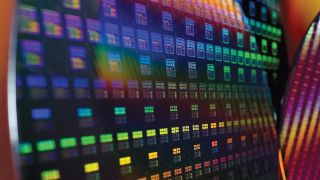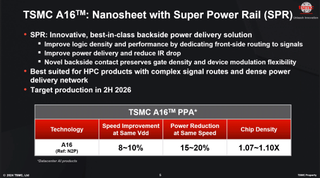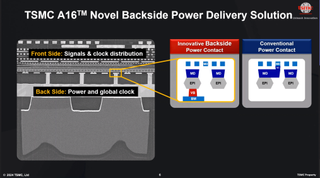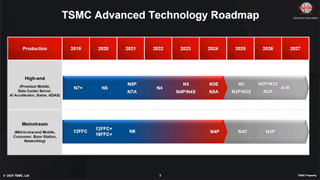TSMC unveils 1.6nm process technology with backside power delivery, rivals Intel's competing design
TSMC goes angstrom-class nodes.

TSMC announced its leading-edge 1.6nm-class process technology today, a new A16 manufacturing process that will be the company's first Angstrom-class production node and promises to outperform its predecessor, N2P, by a significant margin. The technology's most important innovation will be its backside power delivery network (BSPDN).
Just like TSMC's 2nm-class nodes (N2, N2P, and N2X), the company's 1.6nm-class fabrication process will rely on gate-all-around (GAA) nanosheet transistors, but unlike the current and next-generation nodes, this one uses backside power delivery dubbed Super Power Rail. Transistor and BSPDN innovations enable tangible performance and efficiency improvements compared to TSMC's N2P: the new node promises an up to 10% higher clock rate at the same voltage and a 15%–20% lower power consumption at the same frequency and complexity. In addition, the new technology could enable 7%–10% higher transistor density, depending on the actual design.

The most important innovation of TSMC's A16 process, which was unveiled at the company's North American Technology Symposium 2024, is the introduction of the Super Power Rail (SPR), a sophisticated backside power delivery network (BSPDN). This technology is tailored specifically for AI and HPC processors that tend to have both complex signal wiring and dense power delivery networks.
Backside power delivery will be implemented into many upcoming process technologies as it allows for an increase in transistor density and improved power delivery, which affects performance. Meanwhile, there are several ways to implement a BSPDN. TSMC's Super Power Rail plugs the backside power delivery network to each transistor's source and drain using a special contact that also reduces resistance to get the maximum performance and power efficiency possible. From a production perspective, this is one of the most complex BSPDN implementations and is more complex than Intel's Power Via.

The choice of backside power rail implementation is perhaps why TSMC decided not to add this feature to its N2P and N2X process technologies, as it would make using the production nodes considerably more expensive. Meanwhile, by offering a 1.6nm-class node with GAA nanosheet transistors and SPR as well as 2nm-class nodes with GAAFETs only, the company will now have two distinct nodes that will not compete with each other directly but offer distinctive advantages for different customers.

The production timeline for A16 indicates that volume production of A16 will commence in the second half of 2026. Therefore, actual A16-made products will likely debut in 2027. This timeline positions A16 to potentially compete with Intel's 14A node, which will be the Intel's most advanced node at the time.
Stay On the Cutting Edge: Get the Tom's Hardware Newsletter
Join the experts who read Tom's Hardware for the inside track on enthusiast PC tech news — and have for over 25 years. We'll send breaking news and in-depth reviews of CPUs, GPUs, AI, maker hardware and more straight to your inbox.

Anton Shilov is a Freelance News Writer at Tom’s Hardware US. Over the past couple of decades, he has covered everything from CPUs and GPUs to supercomputers and from modern process technologies and latest fab tools to high-tech industry trends.
-
usertests So it's a half node that introduces backside power delivery.Reply
The power reduction is where it's at. Those handhelds need every bit they can get. -
CerianK Just in case anyone needs to hear it, Angstrom-class refers to any process node moving forward where it would otherwise be necessary to include a decimal point in the node descriptor, so 16 Å, rather than 1.6 nm.Reply
That should work just fine for the next 10+ years, barring any sudden paradigm shift (given the number of advanced technologies vying for an opportunity to displace silicon at smaller scales). -
JamesJones44 Reply
The issue is people who don't understand resolutions and distance will be demanding 8K on those handhelds by then and will sap any energy savings gained.usertests said:So it's a half node that introduces backside power delivery.
The power reduction is where it's at. Those handhelds need every bit they can get. -
usertests Reply
I think Steam Deck is leading the pack of x86 handhelds in sales... with a 720p screen. I can't imagine most buyers caring about more than 1080p anytime soon.JamesJones44 said:The issue is people who don't understand resolutions and distance will be demanding 8K on those handhelds by then and will sap any energy savings gained.
BTW, still waiting for 8K mini tablets:
https://www.anandtech.com/show/13742/new-8k-oled-displays -
JamesJones44 Reply
I was exaggerating a bit with 8K, but I read people complaining about smart phone screen resolutions all the time even though you would have to stick you face on the screen to see a pixel for higher end models (which is where I see people saying dumb things like, oh still no 4K...). People also complain a lot about the switch being locked to 720p when in hand held mode, it's not unique to smart phones (heck I see people looking for 8k monitors on random reddit posts to play games).usertests said:I think Steam Deck is leading the pack of x86 handhelds in sales... with a 720p screen. I can't imagine most buyers caring about more than 1080p anytime soon.
BTW, still waiting for 8K mini tablets:
https://www.anandtech.com/show/13742/new-8k-oled-displays
User's who don't understand how resolutions relate to size and distance tend to push these silly things is what I was trying to say. -
zoridon Reply
I agree, I'm running a 32 inch curved 1440p monitor and sometimes I feel I could hold off an extra two years between gpu upgrades if I went back to 1080p with a 27 inch monitor and up my refresh rate at the same time. I don't think I can tell the difference until I hit around the 30 inch level but the extra frames would be nice.JamesJones44 said:I was exaggerating a bit with 8K, but I read people complaining about smart phone screen resolutions all the time even though you would have to stick you face on the screen to see a pixel for higher end models (which is where I see people saying dumb things like, oh still no 4K...). People also complain a lot about the switch being locked to 720p when in hand held mode, it's not unique to smart phones (heck I see people looking for 8k monitors on random reddit posts to play games).
User's who don't understand how resolutions relate to size and distance tend to push these silly things is what I was trying to say. -
brandonjclark Reply
I remember the guy at microcenter trying to tell me I'm wasting my 3090 pushing too few pixels at 1440p (32inches).zoridon said:I agree, I'm running a 32 inch curved 1440p monitor and sometimes I feel I could hold off an extra two years between gpu upgrades if I went back to 1080p with a 27 inch monitor and up my refresh rate at the same time. I don't think I can tell the difference until I hit around the 30 inch level but the extra frames would be nice.
My guy, I care about REFRESH RATE. -
DougMcC Reply
If they had just gone with F instead of A they could have been done for good. :-(CerianK said:Just in case anyone needs to hear it, Angstrom-class refers to any process node moving forward where it would otherwise be necessary to include a decimal point in the node descriptor, so 16 Å, rather than 1.6 nm.
That should work just fine for the next 10+ years, barring any sudden paradigm shift (given the number of advanced technologies vying for an opportunity to displace silicon at smaller scales). -
DougMcC Reply
8k is a good choice for lossless content scaling though. How fine a pixel pitch you can perceive is not the only factor in how good content looks on your device.JamesJones44 said:The issue is people who don't understand resolutions and distance will be demanding 8K on those handhelds by then and will sap any energy savings gained. -
TerryLaze Reply
Huh?! Isn't anything with a 1:1 ratio a "good choice" for scaling?DougMcC said:8k is a good choice for lossless content scaling though. How fine a pixel pitch you can perceive is not the only factor in how good content looks on your device.
Too many pixels on too small of a space will just look like one big chunky pixel to the user, so 8k on a tiny display should look worse than 4k on the same area screen.
Most Popular



